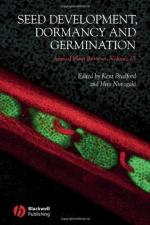|
This section contains 384 words (approx. 2 pages at 300 words per page) |
Germination refers to the beginning of growth of a mature seed, to produce a small plant, or seedling.
All seeds require access to adequate moisture and oxygen and a suitable temperature regime before they can germinate. The seeds of some species must also be exposed to light before they will germinate, although others are inhibited by this condition. The seeds of many plants are capable of germinating as soon as they ripen. In most cases, such seeds are dispersed into the environment, where if they encountered suitable conditions, they quickly germinate to establish a seedling. In rare cases, such as the red mangrove (Rhizophora mangle), the seed actually germinates while still attached to the parent plant, an unusual habitat known as viviparity.
The seeds of many plants, however, must experience a resting or dormancy phase before they are ready to germinate. Dormancy can be related to a number of attributes of the seed, including a seedcoat that is impervious to water and/or oxygen, a hard seedcoat that prevents expansion of the embryo, the presence of chemicals that inhibit germination, or the need for some sort of pre-treatment, such as exposure to cold or dry conditions. Seeds with an impervious or hard seedcoat may eventually soften or otherwise weaken after exposure to moisture and decay in the environment. Alternatively, they may require passage through the gut of an animal (after feeding on the fruit in which the seed was enclosed), or sometimes to fire or repeated freeze-thaw cycles (this requirement of hard-coated seeds is known as scarification). Seeds containing anti-germination chemicals may break dormancy after these substances are washed away by rainwater. Seeds requiring exposure to cold temperature usually germinate in the springtime or early summer (this dormancy requirement is known as after-ripening, and it can often be hastened by keeping the seeds in a refrigerator or freezer for a few weeks or months).
The seeds of some plants can remain viable for a long time, even centuries. In such cases, the seeds persist in the ground (as a so-called seedbank) until conditions suitable for germination are encountered. Seeds of pin cherry (Prunus pensylvanica), red raspberry (Rubus strigosus), and arctic lupin (Lupinus arcticus) have persistent seedbanks of this kind, as an adaptation to recovery after rare events of disturbance of their ecosystem.
|
This section contains 384 words (approx. 2 pages at 300 words per page) |


